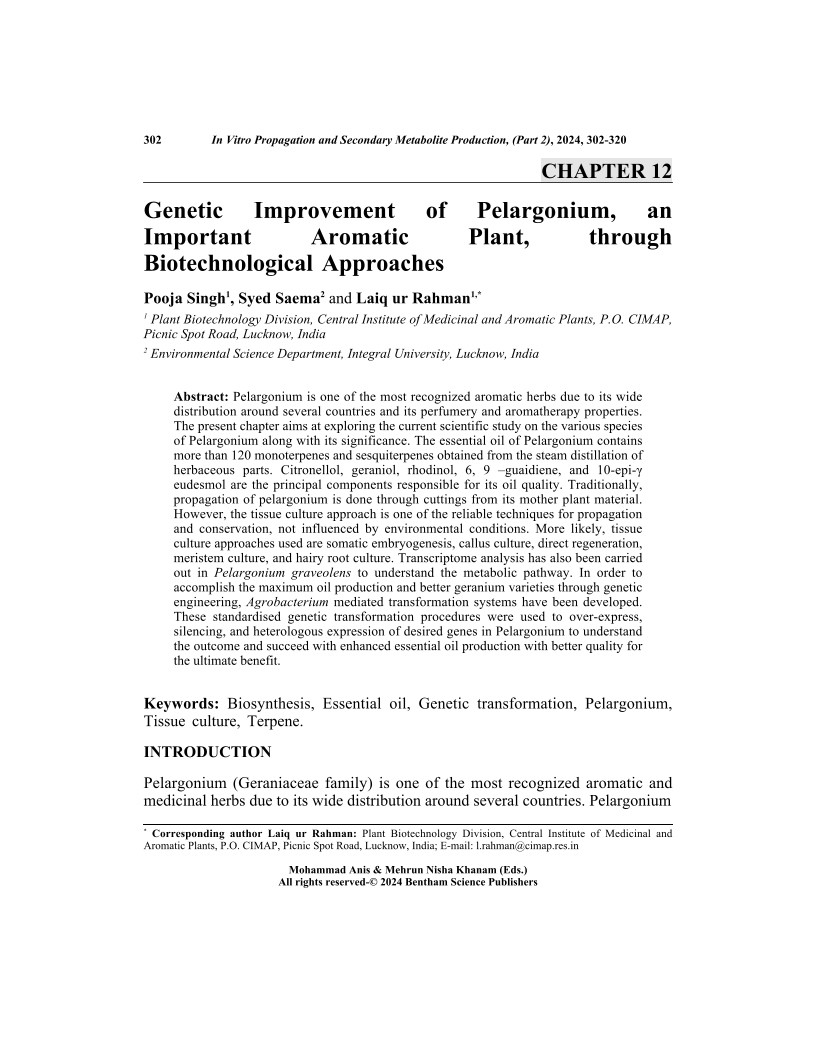- Home
- Books
- In Vitro Propagation and Secondary Metabolite Production from Medicinal Plants: Current Trends (Part 2)
- Chapter
Genetic Improvement of Pelargonium, an Important Aromatic Plant, through Biotechnological Approaches

- Authors: Pooja Singh1, Syed Saema2, Laiq ur Rahman3
-
View Affiliations Hide AffiliationsAffiliations: 1 Plant Biotechnology Division, Central Institute of Medicinal and Aromatic Plants, P.O. CIMAP, Picnic Spot Road, Lucknow, India 2 Environmental Science Department, Integral University, Lucknow, India 3 Plant Biotechnology Division, Central Institute of Medicinal and Aromatic Plants, P.O. CIMAP, Picnic Spot Road, Lucknow, India
- Source: In Vitro Propagation and Secondary Metabolite Production from Medicinal Plants: Current Trends (Part 2) , pp 302-320
- Publication Date: April 2024
- Language: English
Genetic Improvement of Pelargonium, an Important Aromatic Plant, through Biotechnological Approaches, Page 1 of 1
< Previous page | Next page > /docserver/preview/fulltext/9789815196351/chapter-12-1.gif
Pelargonium is one of the most recognized aromatic herbs due to its wide distribution around several countries and its perfumery and aromatherapy properties. The present chapter aims at exploring the current scientific study on the various species of Pelargonium along with its significance. The essential oil of Pelargonium contains more than 120 monoterpenes and sesquiterpenes obtained from the steam distillation of herbaceous parts. Citronellol, geraniol, rhodinol, 6, 9 guaidiene, and 10-epi-γ eudesmol are the principal components responsible for its oil quality. Traditionally, propagation of pelargonium is done through cuttings from its mother plant material. However, the tissue culture approach is one of the reliable techniques for propagation and conservation, not influenced by environmental conditions. More likely, tissue culture approaches used are somatic embryogenesis, callus culture, direct regeneration, meristem culture, and hairy root culture. Transcriptome analysis has also been carried out in Pelargonium graveolens to understand the metabolic pathway. In order to accomplish the maximum oil production and better geranium varieties through genetic engineering, Agrobacterium mediated transformation systems have been developed. These standardised genetic transformation procedures were used to over-express, silencing, and heterologous expression of desired genes in Pelargonium to understand the outcome and succeed with enhanced essential oil production with better quality for the ultimate benefit.
-
From This Site
/content/books/9789815196351.chapter-12dcterms_subject,pub_keyword-contentType:Journal105

